
Albedo is the measure of the diffuse reflection of solar radiation out of the total solar radiation and measured on a scale from 0, corresponding to a black body that absorbs all incident radiation, to 1, corresponding to a body that reflects all incident radiation.
Global warming potential (GWP) is the heat absorbed by any greenhouse gas in the atmosphere, as a multiple of the heat that would be absorbed by the same mass of carbon dioxide. GWP is 1 for CO
2. For other gases it depends on the gas and the time frame.

Smoke is a collection of airborne particulates and gases emitted when a material undergoes combustion or pyrolysis, together with the quantity of air that is entrained or otherwise mixed into the mass. It is commonly an unwanted by-product of fires, but may also be used for pest control (fumigation), communication, defensive and offensive capabilities in the military, cooking, or smoking. It is used in rituals where incense, sage, or resin is burned to produce a smell for spiritual or magical purposes. It can also be a flavoring agent and preservative.
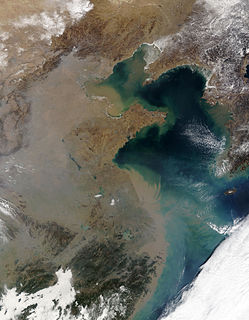
The Indian Ocean brown cloud or Asian brown cloud is a layer of air pollution that recurrently covers parts of South Asia, namely the northern Indian Ocean, India, and Pakistan. Viewed from satellite photos, the cloud appears as a giant brown stain hanging in the air over much of South Asia and the Indian Ocean every year between January and March, possibly also during earlier and later months. The term was coined in reports from the UNEP Indian Ocean Experiment (INDOEX).

The atmosphere of Earth is the layer of gases, commonly known as air, retained by Earth's gravity, surrounding the planet Earth and forming its planetary atmosphere. The atmosphere of Earth protects life on Earth by creating pressure allowing for liquid water to exist on the Earth's surface, absorbing ultraviolet solar radiation, warming the surface through heat retention, and reducing temperature extremes between day and night.
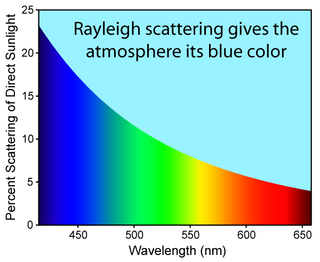
Diffuse sky radiation is solar radiation reaching the Earth's surface after having been scattered from the direct solar beam by molecules or particulates in the atmosphere. Also called sky radiation, the determinative process for changing the colors of the sky. Approximately 23% of direct incident radiation of total sunlight is removed from the direct solar beam by scattering into the atmosphere; of this amount about two-thirds ultimately reaches the earth as photon diffused skylight radiation.

Global dimming is the reduction in the amount of global direct irradiance at the Earth's surface that has been observed since systematic measurements began in the 1950s. The effect varies by location, but worldwide it has been estimated to be of the order of a 4–20% reduction. However, after discounting an anomaly caused by the eruption of Mount Pinatubo in 1991, a very slight reversal in the overall trend has been observed.
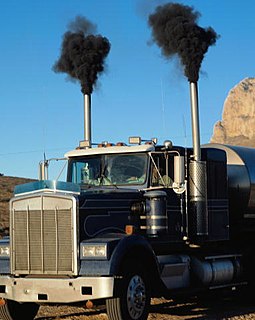
Soot is a mass of impure carbon particles resulting from the incomplete combustion of hydrocarbons. It is more properly restricted to the product of the gas-phase combustion process but is commonly extended to include the residual pyrolysed fuel particles such as coal, cenospheres, charred wood, and petroleum coke that may become airborne during pyrolysis and that are more properly identified as cokes or char.
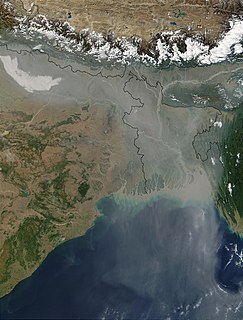
Cloud condensation nuclei or CCNs are small particles typically 0.2 µm, or 1/100 the size of a cloud droplet on which water vapor condenses. Water requires a non-gaseous surface to make the transition from a vapour to a liquid; this process is called condensation. In the atmosphere, this surface presents itself as tiny solid or liquid particles called CCNs. When no CCNs are present, water vapour can be supercooled at about −13 °C (8 °F) for 5–6 hours before droplets spontaneously form. In above-freezing temperatures the air would have to be supersaturated to around 400% before the droplets could form.

Earth's energy budget accounts for the balance between the energy that Earth receives from the Sun and the energy the Earth radiates back into outer space. Smaller energy sources, such as Earth's internal heat, are taken into consideration, but make a tiny contribution compared to solar energy. The energy budget also accounts for how energy moves through the climate system. Because the sun heats the equatorial tropics more than the polar regions, received solar irradiance is unevenly distributed. As the energy seeks equilibrium across the planet, it drives interactions in Earth's climate climate system, i.e., Earth's water, ice, atmosphere, rocky crust, and all living things. The result is Earth's climate.
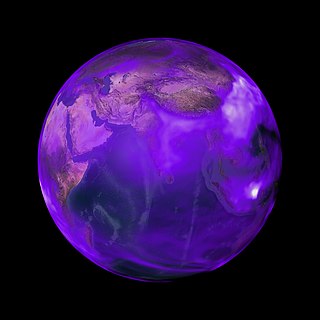
Chemically, black carbon (BC) is a component of fine particulate matter. Black carbon consists of pure carbon in several linked forms. It is formed through the incomplete combustion of fossil fuels, biofuel, and biomass, and is one of the main types of particle in both anthropogenic and naturally occurring soot. Black carbon causes human morbidity and premature mortality. Because of these human health impacts, many countries have worked to reduce their emissions, making it an easy pollutant to abate in anthropogenic sources.
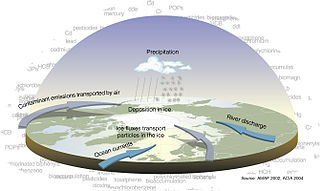
Arctic haze is the phenomenon of a visible reddish-brown springtime haze in the atmosphere at high latitudes in the Arctic due to anthropogenic air pollution. A major distinguishing factor of Arctic haze is the ability of its chemical ingredients to persist in the atmosphere for significantly longer than other pollutants. Due to limited amounts of snow, rain, or turbulent air to displace pollutants from the polar air mass in spring, Arctic haze can linger for more than a month in the northern atmosphere.
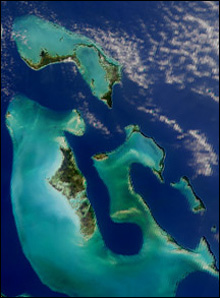
The "color" of the ocean is determined by the interactions of incident light with substances or particles present in the water. White sunlight consists of a spectrum of wavelengths, which water droplets disperse into a continuous spectrum of "rainbow" colors. Large quantities of water, even in a swimming pool, would appear blue as well.

Stratospheric sulfur aerosols are sulfur-rich particles which exist in the stratosphere region of the Earth's atmosphere. The layer of the atmosphere in which they exist is known as the Junge layer, or simply the stratospheric aerosol layer. These particles consist of a mixture of sulfuric acid and water. They are created naturally, such as by photochemical decomposition of sulfur-containing gases, e.g. carbonyl sulfide. When present in high levels, e.g. after a strong volcanic eruption such as Mount Pinatubo, they produce a cooling effect, by reflecting sunlight, and by modifying clouds as they fall out of the stratosphere. This cooling may persist for a few years before the particles fall out.

Mark Zachary Jacobson is a professor of civil and environmental engineering at Stanford University and director of its Atmosphere/Energy Program. Jacobson has developed computer models to study the effects of fossil fuel and biomass burning on air pollution, weather, and climate.
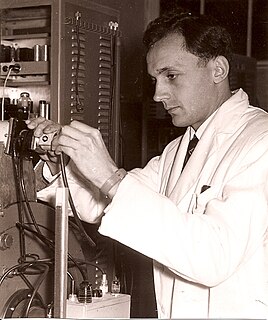
Tihomir Novakov, Ph.D known also as Tica Novakov was a Serbian-born American physicist. As a scientist, Novakov is known for his black carbon, air quality, and climate change research. James Hansen dubbed him "the godfather of black carbon".

Particulates – also known as atmospheric aerosol particles, atmospheric particulate matter, particulate matter (PM), or suspended particulate matter (SPM) – are microscopic particles of solid or liquid matter suspended in the air. The term aerosol commonly refers to the particulate/air mixture, as opposed to the particulate matter alone. Sources of particulate matter can be natural or anthropogenic. They have impacts on climate and precipitation that adversely affect human health, in ways additional to direct inhalation.
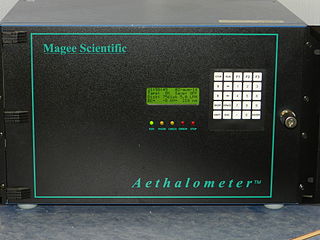
An aethalometer is an instrument for measuring the concentration of optically absorbing (‘black’) suspended particulates in a gas colloid stream; commonly visualized as smoke or haze, often seen in ambient air under polluted conditions. The word aethalometer is derived from the Classical Greek verb ‘aethaloun’, meaning ‘to blacken with soot’.
Tami Bond holds the Walter Scott, Jr. Presidential Chair in Energy, Environment and Health at Colorado State University since 2019. For many years she was a professor of Civil and Environmental Engineering at the University of Illinois, and an affiliate professor of Atmospheric Science. Bond has focused research on the effective study of black carbon or soot in the atmosphere. She is a Fellow of the American Geophysical Union. A MacArthur Fellowship was awarded to her in 2014.

The North Atlantic Aerosols and Marine Ecosystems Study (NAAMES) was a five-year scientific research program that investigated aspects of phytoplankton dynamics in ocean ecosystems, and how such dynamics influence atmospheric aerosols, clouds, and climate. The study focused on the sub-arctic region of the North Atlantic Ocean, which is the site of one of Earth's largest recurring phytoplankton blooms. The long history of research in this location, as well as relative ease of accessibility, made the North Atlantic an ideal location to test prevailing scientific hypotheses in an effort to better understand the role of phytoplankton aerosol emissions on Earth's energy budget.





















